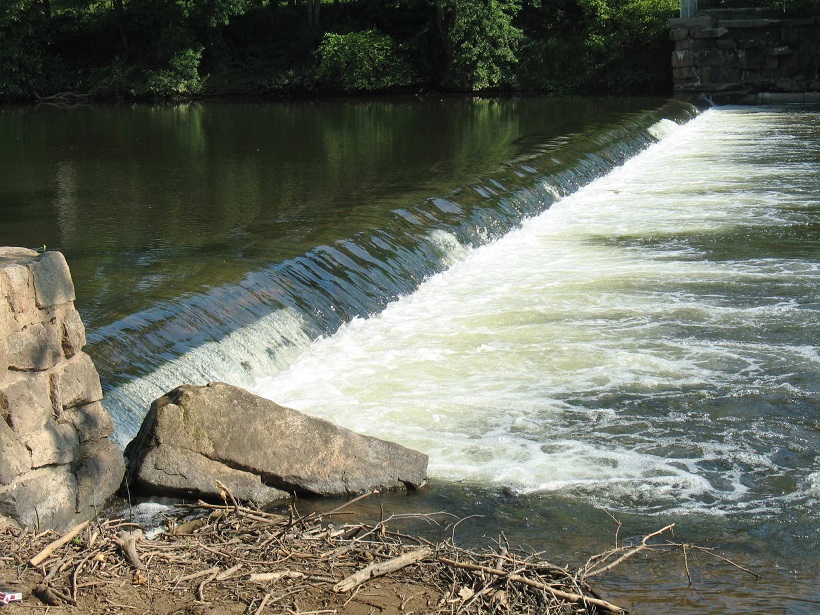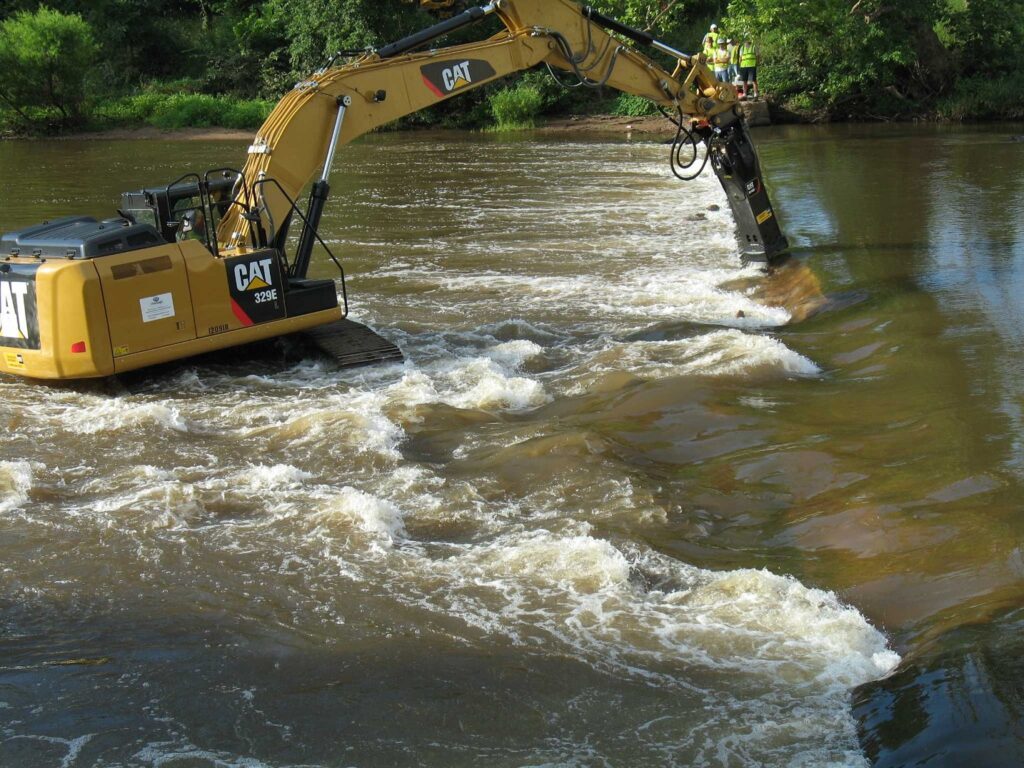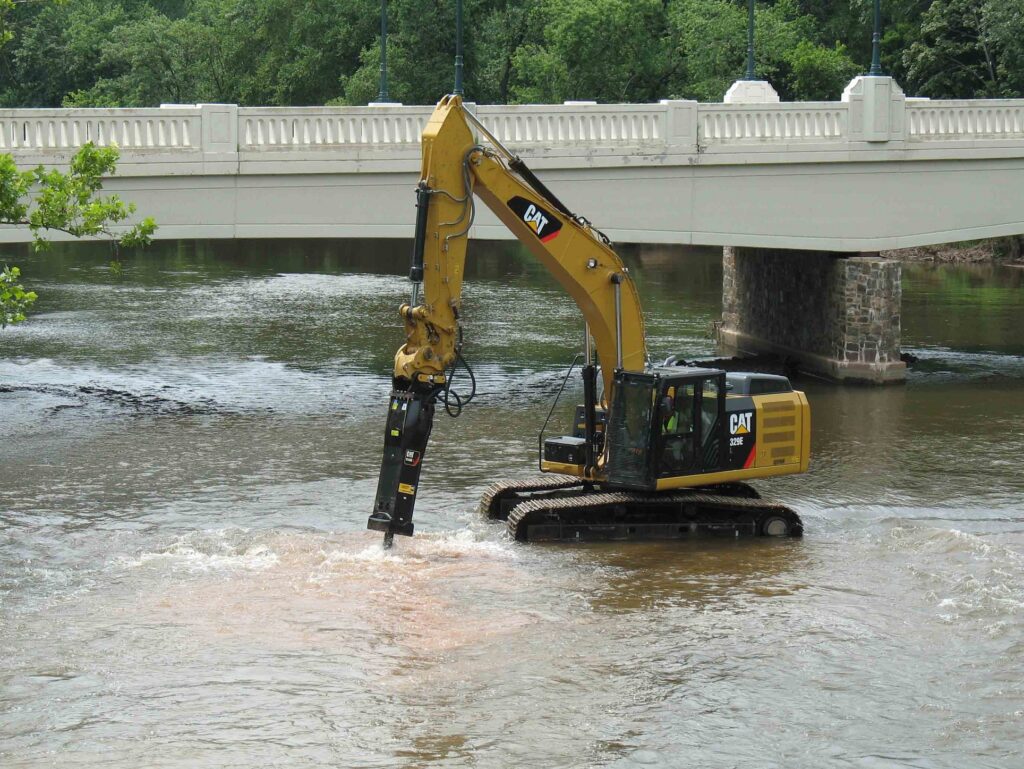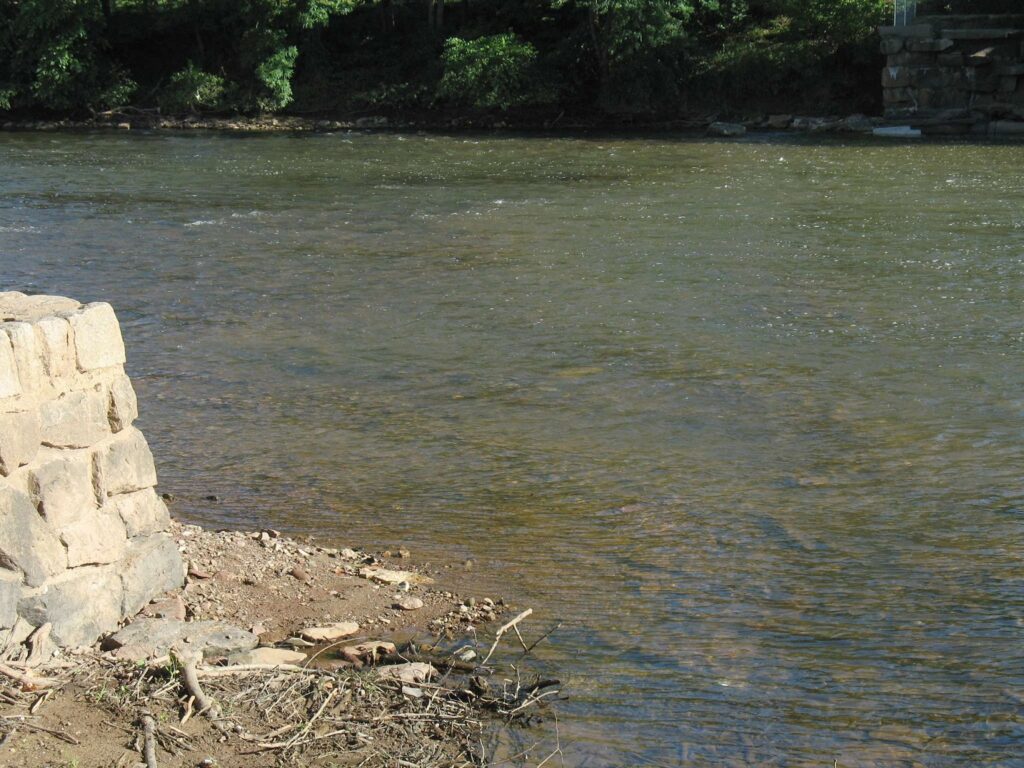Nevius Street Dam Removal
Article and photos by John W. Jengo

The Nevius Street Dam at Raritan River Mile 27.0 was located just south of the Borough of Raritan, Somerset County, New Jersey. This dam, also referred to as the “Duke Dam,” was constructed in 1901 by James Buchanan (Buck) Duke, the tobacco and hydropower industrialist, for aesthetic and recreational purposes as part of his development of Duke Farms, a 2,740-acre estate in Hillsborough Township, New Jersey. Careful examination of the dam indicated that it was constructed of dressed stone blocks arranged in a stair-step fashion set into a concrete core foundation that was 195 feet long, approximately 2.5 feet high from sill to crest, and approximately 6.5 feet in width. The picturesque dam and dam impoundment were often photographed in its early years, and some of these photographs were reproduced in the book Raritan [NJ] – Images of America, published in 2003.
The Nevius Street Dam was subsequently converted into an essential part of the Duke Farms water supply system when water pumping withdrawals from the adjacent Raritan Water Power Canal were discontinued in the early 1970s (this Canal water supply system was the original source of water that was pumped up to Duke Farms for irrigation and for circulation through a series of man-made lakes and waterfalls). This conversion was accomplished by retrofitting a water intake grate on the north side of the dam, and installing a 205-foot long, 30-inch diameter concrete reinforced pipeline that conveyed surface water downriver into a subterranean chamber under the Duke Farms Powerhouse building, which was then pumped up to the Duke Farms reservoir (from there, the water cascaded through the numerous lakes and waterfalls on the property). This modification allowed Duke Farms to utilize the same infrastructure that had previously provided both hydroelectric power and water supply to the property, although now that the surface water was flowing into the river-level penstock of the Powerhouse rather than falling from a substantial height from the Raritan Water Power Canal, the turbines of the Powerhouse were bypassed and, thus, fell silent.
In the runup to its removal, the Nevius Street Dam was still providing a vital service and with the pending removal of the dam, Duke Farms would be without a water supply for their renowned lake system. As part of the arrangement to remove the dam, I performed a hydrogeological study at the property in 2012 to determine if new groundwater supply wells could be installed to replace the Raritan River surface water supply. This alternative proved to be feasible, although it would not be possible to replace the approximately 750,000 to 1 million gallons that was typically pumped up to the Duke Farms reservoir each day. The tradeoff of a lower volume of groundwater was that the groundwater would be free of high concentrations of total phosphorus, ammonia-N, and nitrate-N that are present in the Raritan River, an impairment caused by runoff of fertilizer and manure from agricultural fields, suburban lawns, and golf courses. The Duke Farms Natural Resources team were expectant that the introduction of groundwater without excess nutrients might curtail the growth of curly-leaf pondweed and filamentous mat algae that has afflicted the lakes in the modern era.
The installation of two groundwater water supply production wells was conducted in 2012 and 2016 and befitting Duke Farms’ commitment to the concept of “adaptive reuse,” I and the Duke Farms team conceived of a plan to repurpose underground pipelines that were built in 1909-1910 to connect the new production wells to the reservoir rather than excavate and install thousands of feet of new pipeline through the beautiful and pristine landscape of the property. Detailed analyses of an original 1911 as-built construction drawing revealed an elaborate underground pipeline network not only leading from the Powerhouse to the reservoir that the current dam pumping system was utilizing, but also a second, intertwined pipeline network that formerly conveyed water from a long-lost Recirculation Plant along the Raritan River that had recovered water after it had flowed through the lake system and recirculated it back to the reservoir. This pipeline was relocated in the field, flushed along its re-purposed length to remove accumulated sediment from its original operation, had its various values replaced, and was then connected to the new groundwater well field. This reconfiguration of the water supply system has proven to be a great success and it allowed for the removal of the Nevius Street Dam, which was accomplished between July 24-July 31, 2013.


In closing, I would like to acknowledge former Executive Director Michael Catania, Jon Wagar (Deputy Director), and Thom Almendinger (Director of Natural Resources and AgroEcology), and the Doris Duke Charitable Foundation Board for their cooperation and consent to remove the Nevius Street Dam. Implementing this consequential water supply exchange from surface water to groundwater was not without risk so I am truly grateful for their trust, financial support, and steadfast resolve to implement this project, proving yet again that Duke Farms is a leader in environmental stewardship and an inspiration for citizens to become informed stewards of the land.

John W. Jengo, PG, LSRP is a licensed Professional Geologist in several Northeastern and Southeastern states and a Licensed Site Remediation Professional in New Jersey. John works as a Principal Hydrogeologist in an environmental consulting firm in southeastern Pennsylvania. He has degrees in geology from Rutgers University (1980) and the University of Delaware (1982). Over the last 30 years, he has conducted the characterization and remediation of large, complex contaminated industrial sites throughout New Jersey, Pennsylvania, and Delaware. He played a key role in Natural Resource Damage (NRD) assessments that led to groundbreaking legal settlements to remove numerous low head dams on the Raritan and Millstone Rivers to restore historically significant migratory fish spawning runs. As technical project manager, he planned, permitted, and successfully managed the removal of the Calco Dam, the Robert Street Dam, and the Nevius Street Dam between 2008-2013, and the removal of the Weston Mill Dam on the Millstone River in 2017, along with leading the archaeological investigation of the former Weston Mill in the Borough of Manville and Franklin Township.
